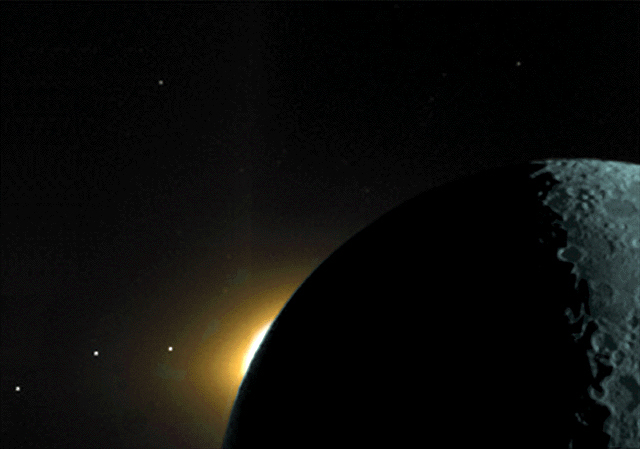
The search for extraterrestrial intelligence needs all the help it can get. Depending on who you listen to, the chances of us spotting an intelligent technological society vary from an almost certainty to practically zero.
The trouble is the sheer size of the search. The Milky Way contains around 10^10 sun-like stars, any one of which may have a planet whose citizens are at this very moment pointing their beady eyes or antennae in our direction.
But if we want to peer back, in which direction should we look?
Shmuel Nussinov at Tel Aviv University in Israel makes a thoroughly sensible suggestion of narrowing the search: why not look only towards stars that have a reasonable chance of having seen Earth?
We know of several ways to detect planets aroudn other stars but only one that might reveal an Earth-like body and that is to look for changes in brightness that are the signature of a transiting planet.
Earth passes in front of the sun for 13 hours once a year, dimming it by 77 parts per million. Venus transits for 11 hours every 7 months with even less dimming. Mars gives three-fold weaker eclipse every 1.9 years and Mercury dimming is ten times weaker than Earth’s but occurs four times a year.
Only stars within a narrow angle of the ecliptic will be able to detect these transits. And so only civilisations on planets around these stars could possibly be aware of Earth might be broadcasting our way.
Common sense really.
Ref: arxiv.org/abs/0903.1628: Some Comments on Possible Preferred Directions for the SETI Search
This assumes that ET are attempting to communicate with us specifically and not just broadcasting in our general direction. Seems hubristic to me.
Subject: Narrow down the ET search window
Sorry if this is a stupid idea …
… I am not a cosmologist.
Hypothesis:
our POSITION on the spiral arm of our galaxy
(meaning the DISTANCE to the CENTER of
the milky way, measured along the SPIRAL TRAJECTORY)
MIGHT have something to do with the AGE
of our solar system.
[Or INVERSELY, the same kind of distance,
but measured to the END of our spiral arm?]
IF one of those hypotheses would be correct,
I suggest to look for civilisations that
SHARE EXACTLY THE SAME SUCH POSITION with us
(perhaps corrected by the speed of light?)
Because intelligent life
with the urge to communicate
could be a really short-lived phenomenon.
e.g.:
Look how fast they destroy our ecosphere…
“This assumes that ET are attempting to communicate with us specifically and not just broadcasting in our general direction. Seems hubristic to me.”
Dude, ever heard of the inverse-squared law? If we ever hear from someone, it ain’t going to be their version of coasttocoast AM radio. It will require powerful FOCUSED beams.
Andreas: that’s a seemingly good idea. Only problem is that evolution isn’t as predictable as baking a cake. There was nothing in the body plans of dinosaurs that prevented them from evolving into a human-equivalent species 100 million years ago. (Arguably, it should have been easier for them since there were so many bipedal dinosaurs compared to the near universally quadrupedal mammals.) And arguably it was an evolutionary fluke that we evolved at all. If we didn’t, who knows how long it would take some other lineage (if ever) to evolve into a technological species. Then there’s the problem of evolving metazoan (i.e., BIG, multicellular organisms) in the first place. It took 3 billion years for that to happen on Earth, so it’s probably not easy to do. But yes, your suggestion could reasonably limit the search to planets around main-sequence stars that are between ~3 to ~5 billion years old. That’s a big window, but a lot smaller than EVERYTHING.
If we don’t search for alien life, we will not find it.
Period.
[…] ¿Y si buscásemos vida sólo en los exoplanetas desde los que la Tierra es visible? (ING)arxivblog.com/?p=1297 por jm22381 hace pocos segundos […]
[…] Is there anybody out there?Al sinds jaar en dag wordt jacht gemaakt op intelligent buitenaards leven. We kennen allemaal SETI, de search for extraterrestrial intelligence. Maar ja, probleem is bij deze en andere zoektochten: waar moet je precies naar kijken? Er zijn meer dan 100 miljard sterren in onze Melkweg en die kunnen bijna allemaal exoplaneten bevatten waarop wellicht ET’s rondlopen, -dwarrelen, -kruipen, etc… Beetje onbegonnen werk om al die 1010 sterren in de gaten te houden en te ‘luisteren’ naar signalen van zo’n extraterrestrial. Gelukkig is daar ene Shmuel Nussinov (Tel Aviv Universiteit), die op het praktische idee gekomen is om de zoektocht te finetunen. Hij gaat uit van dé methode die we op Aarde gebruiken om andere exoplaneten te zien, namelijk de transitiemethode. We kijken naar sterren en als het licht daarvan eventjes dimt is dat een signaal dat er vanaf de Aarde gezien
Given that any alien civilisation we find is likely either going to be way, WAY more advanced than us or still in the primordial soup phase, if they are able to look for us then it is probable that they have telescopes which can spot planets without having to look for any eclipsing effect. Obvious, really.
The majority of people today including S.E.T.I. are under the gross assumption that higher intelligences are using primitive radio waves to communicate via interstellar distances. Another carrier is used for Faster than Light communication via C-energy frequencies of C-domain. Another science is used as well.
The point is that maybe the ETs don’t want to contact with us. I mean, maybe the do not have anything to talk about, with us (or maybe yes). I leave a question for you: Do we have something to share with them?.